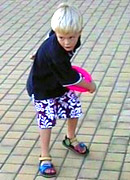Learning from your observations
Did you know?
Experiences children are offered should be based upon interests, responsive to needs, and capable of extending development.
Remaining objective
When observing a child, you need to describe exactly what is happening, without adding your own interpretation. Read through the resource below for further detail.
Being able to record observations with a lot of detail takes much practice and experience.
Have a look at the pictures below and describe in detail what is happening in each photo. Write your observations in your notebook. Don't forget to keep your observations objective.
| Observation 1 | Observation 2 |
|---|---|
 |
 |
It takes practice to be able to look closely at something and describe it in complete detail. It's easy to overlook things that you wouldn't normally notice, such as how someone is holding their pen.
You can practice your observing skills further by asking a friend or family member if they would mind being observed by you for a short period of time. Observe the person and write down what you see in as much detail as you can. Try watching your friend or family member for about two minutes.
You could even practice observing using a television show or watching an animal going about its business.
What you can learn from your observations
Look at the resource below to see what can be learnt from the observations you have made.
What you can learn from observations
Secondary sources
Another effective way to develop an understanding of a child’s interests and developmental needs is to gather information from secondary sources such as family and outside research.
Zeyneba is one of the children at Cybertots. She and her family are from Iran. To improve her understanding of Zeyneba, her caregiver Sara thought it would be helpful to talk to her parents about their family’s cultural practices. As English was their second language, Sara spoke to her director about asking for assistance from an interpreter. Sara also looked for some information on the internet and books to read up about cultural practices in Iran.
To make sure you have completed all the activities for this section, you can use the Activity Checklist (Word 72Kb). You can print the checklist to keep in your notebook.




